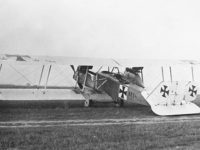The Hansa-Brandenburg G.I was a German bomber built by the Hansa and Brandenburg Airplane Works built exclusively for the Luftwaffe of Austria-Hungary.
Development and construction:
The company Hansa and Brandenburgische Flugzeug Werke originated from the merger of the Brandenburgische Flugzeugwerke GmbH and the Hansa-Flugzeug Werke in 1914. Already from the beginning the aviation pioneers Igo Etrich and Ernst Heinkel, who already had both experiences in aircraft construction, were involved.
Under their leadership, at the beginning of the war, at first unarmed, later armed reconnaissance aircraft were built for the German and for the Austro-Hungarian army. At the end of 1914, when the German army command set the requirements for a bomber to replace the zeppelins, the two designers also began to develop a corresponding aircraft.
The first two prototypes were called ZM I and ZM II, but could not meet the requirements. Only the Hansa-Brandenburg GF, which was later renamed Hansa-Brandenburg G.I, was able to convince.
Two 160 hp Austro-Daimler engines were installed. The pilot and the stern shooter shared a pulpit while the bowman received a separate pulpit. Unlike other aircraft, the engines were not mounted on one of the wings but sat with steel braces fastened in between. This had the disadvantage that the vibrations made themselves felt strongly.
With the entry of Italy into the war on the part of the Allies and their bombardment at the front, the military leadership of Austria-Hungary decided to buy bombers. Initially, two Hansa-Brandenburg G.I aircraft were ordered. However, the damage during transport and the subsequent legal dispute over the compensation, delayed their use at the front considerably. After this was settled, some aircraft were rebuilt under license and ordered more aircraft in early 1917.
Use in the First World War:
After some aviation companies of the Austro-Hungarian Air Force were equipped with the bombers, it was already clear that these aircraft were already outdated and the German Gotha G.IV bomber were much more modern.
Overall, the Hansa-Brandenburg G.I aircraft were deployed for only three months at the front, flying only one attack. Afterwards, these were only used for training.
Technical specifications:
| Designation: | Hansa-Brandenburg G.I |
| Country: | German Empire Austria-Hungary |
| Typ: | Bomber |
| Length: | 9,8 meters |
| Span: | 18 meters |
| Height: | 4,2 meters |
| Mass: | 1.776 kg empty |
| Crew: | Max. 3 |
| Engine: | two water-cooled 6-cylinder inline engines Austro-Daimler with each 160 hp |
| Maximum speed: | 143 km/h |
| Reach: | 1.000 kilometers |
| Armament: | 2 x machine guns 07/12 and up to 300 kg bombs |
You can find the right literature here:
Fokker Dr I Aces of World War 1 (Aircraft of the Aces)
Undoubtedly the most famous fighter type to see service on either side during World War 1, the Fokker Dr I was a revelation when it entered service on the western front in 1917. Manfred von Richthofens JG 1 circus was the first Jasta to completely re-equip with the new fighter, and in the skilled hands of its numerous aces the Dr I proved a formidable opponent. The Dr I remained in service on the Western Front until replaced by the superior Fokker D VII in May 1918. Just weeks prior to that, however, Germanys leading ace, the great Red Baron, had been killed at the controls of a Dr I.
Friedrichshafen Aircraft of WWI: A Centennial Perspective on Great War Airplanes (Great War Aviation) (Volume 21)

Friedrichshafen Aircraft of WWI: A Centennial Perspective on Great War Airplanes (Great War Aviation) (Volume 21) Paperback – February 16, 2016
This book describes and illustrates the development of Friedrichshafen aircraft of WWI with text, 540 photos, 18 in color, 37 color profiles, production quantities and serial numbers of aircraft, and aircraft dimensions and performance specifications. In addition, there are 26 official SVK drawings and 11 aircraft are illustrated in scale drawings to 1/48 (4) or 1/72 (7) scales. The book has 312 pages and is of interest to aviation historians, enthusiasts, and modelers alike.
German and Austro-Hungarian Aircraft Manufacturers 1908-1918
Much has been written about the British aircraft of the First World War, but little has surfaced about the aircraft of the Axis powers, Germany and Austria. Here, Terry C. Treadwell tells the story of the aircraft from companies such as Fokker, builder of the famous triplane, as fl own by Baron von Richthofen's Flying Circus, AEG, Albatros, Junkers and Hansa. From reconnaissance aircraft to state-of-the-art bombers that could reach London, this is the definitive guide to aircraft of the Axis powers during the First World War. The aircraft are explained in detail and a history of each company is provided, making this an excellent source book for aircraft enthusiasts, model makers and those interested in the air war over the trenches of France and Belgium, as well as further afield in the Italian campaign.
The Zeppelin in Combat: A History of the German Naval Airship Division
The standard reference now revised and expanded. Dr. Robinson has opened up his vast photo archives to enhance this new edition of his classic work. Much of the new photographic material is published here for the first time.
This post is also available in:
 Deutsch (German)
Deutsch (German)  Français (French)
Français (French)  Italiano (Italian)
Italiano (Italian)  简体中文 (Chinese (Simplified))
简体中文 (Chinese (Simplified))  Русский (Russian)
Русский (Russian)  Español (Spanish)
Español (Spanish)  العربية (Arabic)
العربية (Arabic)















